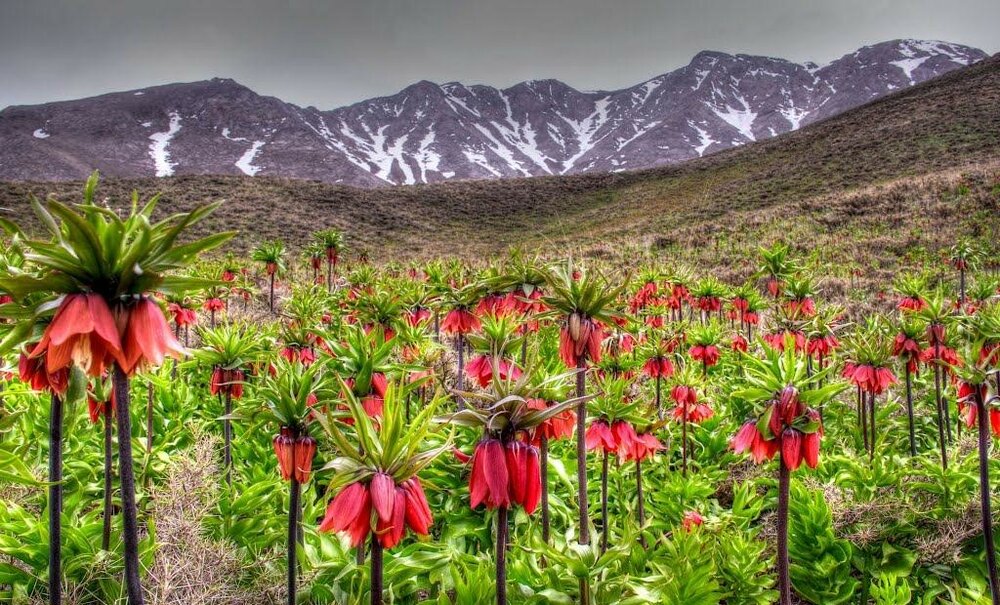Iran’s precious crown imperial on the brink of extinction

TEHRAN – The fascinating crown imperial (fritillaria imperialis), precious part of Iran’s botanical richness, is being pushed to the brink of extinction due to inappropriate herbivory, overgrazing, land use changes, illegal bulb and flower harvest, road construction, mining activities and drought.
Endemic to a wide stretch from Anatolia across the plateau of Iran, southwestern province of Kohgiluyeh and Boyer-Ahmad, to Afghanistan, Pakistan and the Himalayan foothills, crown imperial is a species of flowering plant in the lily family.
Fritillaria imperialis grows to about 1 meter in height and bears lance-shaped, glossy leaves at intervals along the stem. It bears a prominent whorl of downward facing flowers at the top of the stem, topped by a 'crown' of small leaves, hence the name. While the wild form is usually orange-red, various colors are found in cultivation, ranging from nearly a true scarlet through oranges to yellow.
Iran shares a genetic diversity of important species, like Fritillaria genus which includes 100 species, of which 14 species are native to the country, unfortunately, many of the bulb flowers across the country are put at the risk of eradication in recent years.
Although, climatic conditions and overgrazing are two important factors affecting species composition and biodiversity in semi-arid ecosystems, destructive human activities are not deniable in putting the species at risk or pacing up the extinction.
Despite the importance of this plant in various scientific, environmental and tourism terms, in recent years a large part of the fritillaria imperialis plain in Koohrang city located in Chaharmahal Bakhtiari province has been largely damaged.
Lotfali Cheraqpour, head of the provincial forests, range and watershed management organization said that the fritillaria imperialis plain in Koohrang city which once stretched to 3,600 hectares, is decreased to less than a thousand hectares.
Referring to human activities as the leading cause of the species eradication, he noted that Koohrang plains covered with this fabulous flower bulb attract many nature lovers, while tourist’s enthusiastic pickings and locals taking the invaluable specie for granted put the species in an escalator to extinction.
Koohrang plain hosts 50,000 to 100,000 environment enthusiasts annually, while this capacity could be used to flourish tourism in the region, not only no plans are drawn up in this regard, but the widespread presence of tourists has made it harder to protect the flowers, he lamented.
Some people pick the flowering stems just for their fleeting beauty and take them to their homes, but due to the bad smell released by the plant after being picked, it cannot be kept at home, he said, regretting, therefore, this kind of harvesting has no benefit for the gatherer, and adversely affects plant growth cycle.
Animal crossing the plains directly damages blooming plants and prevents fruit and seed formation as well, as the flowering season of some bulbous plants coincides with early spring throughout the country and this time of the year is suitable for the regular migration of nomads from subtropical and tropical regions to temperate ones, so the plants are eaten by animals or trampled.
Promoting the protection culture and making people aware of the species importance can play a significant role in environment conservation, so imminent measures must be taken in this regard and training the locals not to harvest the flowers as a way of income generation, Cheraqpour highlighted.
Morteza Zamanpour, Koohrang city governor also said that it is planned to ban any entrance to the area by the next year for 4 years in order to preserve the crown imperial from extinction.
It will be soon addressed with a special working group and will be implemented in case of approval, he added.
Excessive grazing of the species, changing the habitat to agricultural lands and pest overflows and not having protecting rule or preservation plan, have compounded the situation for this valuable bulb plants, he regretted.
Preventing this tragedy and conservation of Fritillaria require urgent attention, otherwise, it will be removed rapidly from their place of origin, he concluded.
Increasing protected areas, preparing preservation plans, efficient propagation methods such as micro propagation, highlighting the role of non-governmental organizations, gathering the endangered species in research centers, promoting tourism and using its income in line with conservation measures, are among the solutions for better conservation.
Meanwhile, rules and regulations to protect the plant species on national and international scale must be issued to save this invaluable natural heritage.
FB/MQ/MG

Leave a Comment